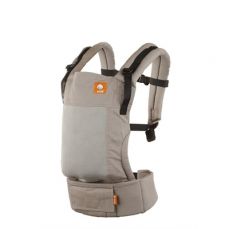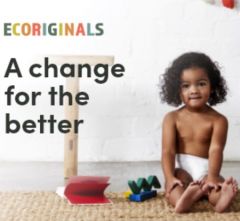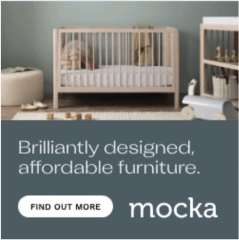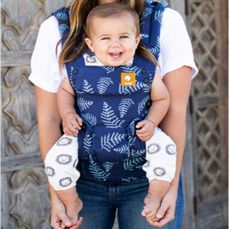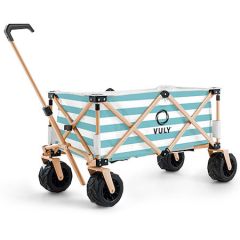Choosing a Convertible Car Seat Transport Suitable for stages: Pregnancy, 0 - 3 Months, 3 - 6 Months, 6 - 12 Months, 12 - 18 Months
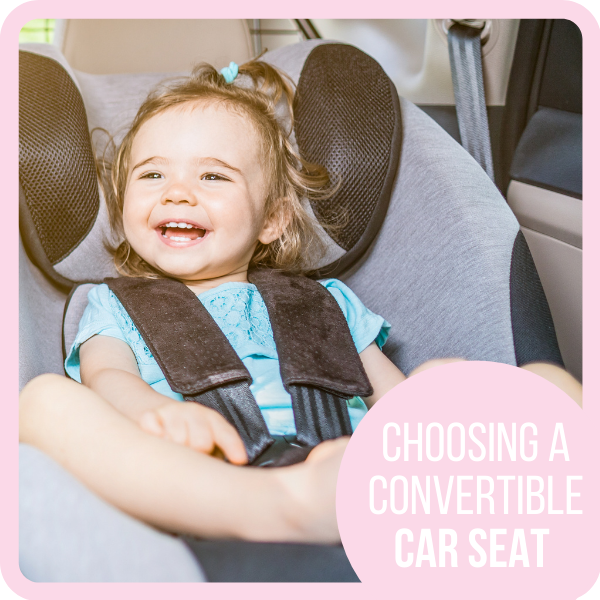

Before your baby even arrives, you have a few important decisions to make. Two of the biggest purchases can be the first car seat and the pram/stroller.
Your car seat could influence your choice of pram/stroller and vice versa if you want to use a travel system (car capsule is compatible with a stroller frame).
Newborns can be fitted in either a convertible car seat or a car capsule system from birth. Rearward facing car travel in an approved car seat is law in Australia up to at least 6 months old. After 6 months, they can be forward faced, however many seats allow from extended rearward facing until 12 months, others up to 30 months.
This guide explores in depth everything you need to know about convertible car seats.
What is a Convertible car seat?
This is a car seat which will convert between 2 or 3 types of car travel modes as baby grows. All convertible seats convert from rear-facing to forward-facing to last at least from birth to 4 years. Some seats also convert to a booster seat to last from newborn right through to 8 years old.
What are the types?
Convertible car seats come in 4 main types, with advantages and disadvantages for each. They also carry very different price points due to their age range and features. Car seat manufacturers are continually innovating towards safer seat options to meet parent’s needs, so before long there could be more types of these seats to choose from.
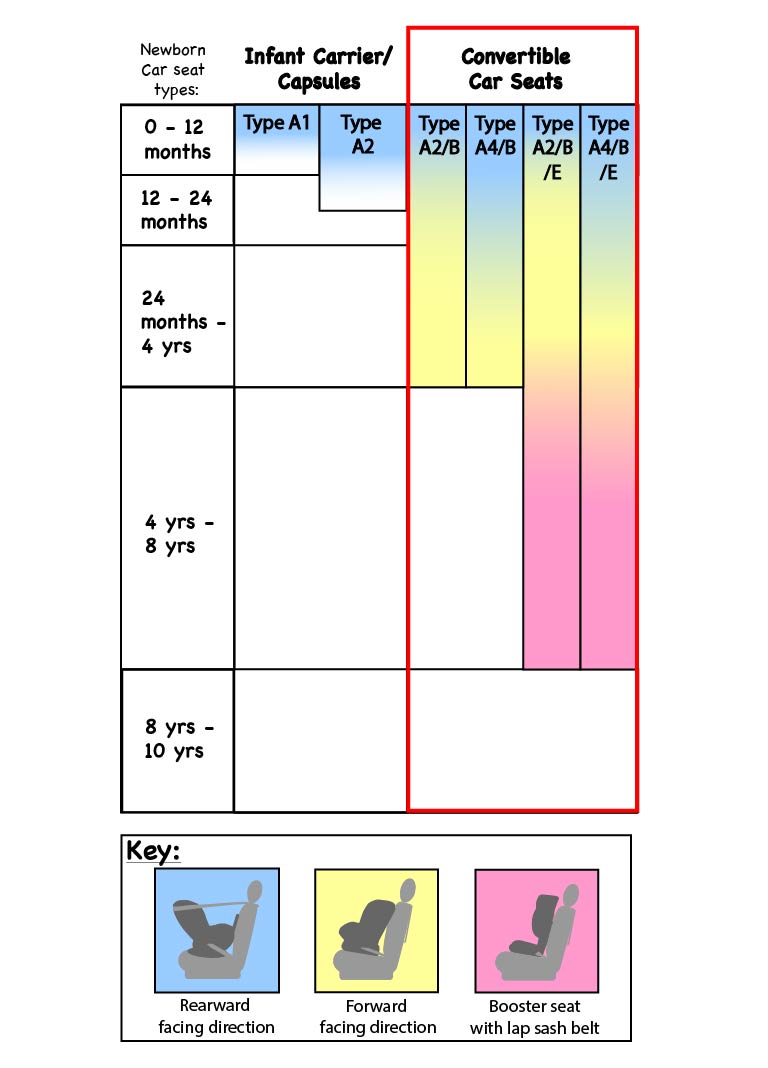
Type A2/B: This type allows for rearward facing from birth up to between 6-12 months (A2). This then converts to a forward-facing seat with a 5 or 6 point harness suitable for up to the 4-year-old (B).
Type A2/B/E: This the same as the A2/B type but can also convert to a booster seat (using the lap-sash belt installed in the car) from between 4-8 years. The booster seat mode is known as type E. This makes this type suitable from birth until 8 years in one seat.
Type A4/B: This type allows for rearward facing from birth up to around 30 months (A4). This then converts to a forward-facing seat with a 5 or 6 point harness suitable for up to the 4-year-old (B).
Type A4/B/E: This the same as the A4/B type but can also convert to a booster seat (using the lap-sash belt installed in the car) from between 4-8 years. The booster seat mode is known as type E. This makes this type suitable from birth until 8 years in one seat but with the additional safety feature of extended rear-facing mode.
How does it work?
In rear-facing mode, typically the child is reclined with the spine supported on a flat padded surface with hips at roughly 90°. Newborns should be reclined between 130-180° due to their poor head control. Most brands offer additional padding (newborn insert) option to support the smaller baby around the hips. Some also offer additional padding around the head for the newborn. The additional padding can be removed once baby grows larger.
The car seat and base is one unit which is installed to one of the backseats of the car. Once installed, it stays in place until baby grows out of that mode.
The seat is secured in place using either Isofix fasteners or a sash belt (with or without a gated clip). A top tether strap attaches to the top of the seat and attaches to a fixed anchor in the car (usually behind the car’s back seat in the boot area).
The seats have multi-recline options, adjustable as baby grows and gains more head control.
The car seat is used only for car travel. Baby is secured in the 5 or 6 point harness during car travel. The caregiver needs to lift the baby out of the car when they reach their destination.
When out and about, you can carry your baby in arms, wear a carrier or put them into a bassinet or stroller seat suitable for a newborn (lay flat seat or seat recline over 130°).
What are the benefits?
There are benefits to using a car convertible car seat. These include:
The Good:
1. Long-lasting
You only need to buy one seat from 4 years to 8 years. Choosing a 0-4 option means only having to buy a relatively cheaper booster seat once your 4-year-old outgrows their seat. Choosing a 0-8 option means not having to worry about buying another seat down the track. Seats generally need replacement after 8 - 10 years, so this one seat may be ready for disposal after being used up to the maximum age.
Baby also gets the familiarity of only having one seat for both rearward and forward-facing.
Good quality Convertible seats are not cheap but when safety is concerned, spending a bit extra will be worth the peace of mind. The price is consistent with the use you will get out of it over many years.
2. Safety of extended rearward-facing past 6 months
Extended rearward-facing is the safest option due to the increased protection & support of the neck and head in an accident. Convertible seats at a minimum allow for rearward facing up until 12 months. Even better is that most now offer extended rearward facing with some being suitable for up to 4-year-old. Even if you forward face earlier, it is good to have the option.
3. Larger flatter seat which grows with baby
Provides a larger and flatter seat and larger headspace to accommodate the growing baby. This makes these seats less cocoon-like for a newborn, but this is better for giving baby space to stretch out and have a flatter back for better breathing.
4. Encourages more engagement with baby when out and about
Provides more opportunities to touch and carry as well as respond to the needs of your baby as they need to be lifted in and out of the car- this is great for their sensory system.
5. No compatibility issues with your pram/stroller choice
If you choose and convertible car seat, then your pram/stroller choice is unlimited. For your newborn, you may want to buy a bassinet so they can lay flat, or just choose a stroller which has a lay-flat seat.
What are the risks and pitfalls?
The risks of these seats mostly involve user error with installation, adjustment and safe use. There are some pitfalls to be aware of:
1. Not very supportive around the head for a small baby
A convertible seat is designed for a large age and size range, and therefore aren’t usually supportive around the head for very small babies. For newborns, an infant insert that comes with the seat or purchased as an optional extra may improve safety and positioning for very small babies with poor head control. The seat manufacturers warn that it is not safe to use unapproved head supports with their car seats and will advise if there are any approved options to choose depending on the car seat model.
They are only very small babies for such a short time, that it may not be a problem.
If you are concerned about this or have a premature baby, it may be worth checking on available head support options before buying.
2. Width of seat can be a space issue in a smaller car
Convertible seats can take up a lot of space due to their width and large age range. Look for narrow or compact options to fit small cars or where multiple seats are required.
3. Not all seats can be adjusted with ease as your baby grows
Babies grow so fast and the seat needs to grow with them. When baby's shoulders grow past the shoulder strap height, the straps need to be moved up. Some seats require the caregiver to re-thread the shoulder strap to a higher setting which can be frustrating. Other seats have an easy-adjust system where the straps can be pulled higher with the headrest.
Before buying it is worth checking that the seat is easy to adjust.
4. With a lot of features, the learning curve is greater
Convertible seats have a lot of features and can be adjusted in multiple ways. It is important to become familiar with the seat features before you start using it. Finding the installation instructions and user manuals on the manufacturer’s website can help. There may even be instructional videos available online. The more complex the features and adjustments of the seat, the larger the learning curve. Thankfully, there are loads of professional installers to get the seat into the car, however, the user still needs to know what it can do, when to adjust and how.
What are the alternatives?
A car capsule/carrier car seat is the only real alternative to a convertible car seat for a newborn. Capsules are designed to be compatible with certain stroller frames for easy transportation. These are also known as travel systems. If wanting to attach the capsule to a pram/stroller, it’s worth deciding on the capsule when deciding on the stroller to ensure compatibility.
After the baby outgrows their carrier/capsule at between 6 to 18 months, there is then only 2 options: to purchase a convertible car seat at that stage to extend rearward facing, or to move to a forward-facing harnessed seat.
Forward-facing harnessed seats are legal for use in Australia from 6 months. Many people, however, believe these laws are not strict enough and choose to extend rear-facing. For extended rearward facing, the only option is a convertible car seat.
Forward-facing in a harnessed seat can be suitable from 6 months to 4 years or 6 months to 8 years. Between 4 - 8 years, the child can travel in a full harnessed seat or a booster with a lap-sash belt.
For more information, see the car seat types in the child car seat buying guide & more information in the Choosing a Forward-Facing Car Seat article.
Making a decision on a convertible car seat:
You may be confident a convertible car seat will suit your needs, with the right knowledge, you can choose something which fits your unique needs.
If extended rearward-facing is important to you, you just need to decide on whether you need the seat to last to 4 OR 8 years.
Deciding this may mean comparing the cost of buying the 0-4 seat + a booster seat down the track versus the 0-8 option.
If you are planning on having children with a large age gap, having a 0-4 seat can work well - when your new baby arrives, the older child graduates to a booster and the baby has the 0-4 seat.
For children close to together, they may both be rearward facing at the same time, so 2 convertible seats will be needed.
For children somewhat close together, the 0-4 may go to the baby and the older child could graduate to a forward-facing harnessed seat.
By the time you finish using the 0-8 seat, it is approaching its expiry date (usually 10 years) and could be so well worn that it is ready for disposal.
Every family will be different and have different needs, now you know some of the options, the hard part is figuring what is going to suit your family.
We hope you find the perfect option for you.
Search for Car Seats on the Baby Bunting | eBay Store
Please note: Above all, any information on this website aims to provide general ideas for informational and educational purposes only. We encourage users to investigate several information sources, including, where necessary, independent individualised medical advice before making any decisions that could affect you or your child’s health or wellbeing.
* BabyPeg participates in various affiliate programs and may earn a commission for referring our users through the links provided. This is at no additional cost to our users. We take great care in choosing products and services which align with the mission of promoting better health and wellness for our BabyPeg community. Where possible, products are tried and tested by us. To continue to provide BabyPeg as a free service and reach as many parents as possible, we appreciate your support in using the link provided to purchase if you decide the product is right for you.
